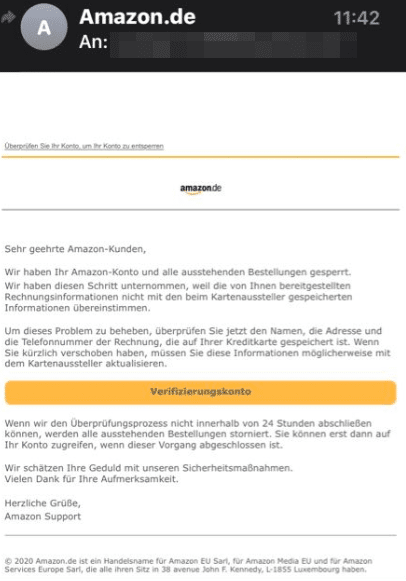They are designed to be deceptively realistic and put users under pressure - but be careful! All these emails don't from Amazon!
Alleged emails from Amazon are sent again and again. But in reality this comes from criminals who want to use it to steal other people's money.
Current example of a fake Amazon email:

How do I recognize a phishing email?
- Most of the time you will not be contacted personally. Scammers use phrases like “Dear customer”.
- The pretext is unrealistic and the email is full of grammatical and spelling errors.
- The return address is not the service address of the named company.
- The login page link does not match the link of the correct page.
- The links to data protection, general terms and conditions, legal notice, etc. do not work.
- As a general rule, Amazon does not ask you to disclose personal information via email.
In order to check whether an email could be genuine, you should not click on the links in the email, but rather go to the corresponding page directly in the browser. In this case, you should open the browser, go to Amazon as you usually do and look in the customer account under orders to see whether this order really exists.
General phishing warning:
- Phishing emails generally try to appear as if they come from the company in question . Fraudsters use them to try to get personal data, preferably bank and credit card or other payment details.
- Protection software is helpful! With updated databases and appropriate heuristics, malicious sites are often blocked.
- The real “art” of these emails is the story with which the recipient is supposed to trust the email and open the inserted link. Expression, grammar and spelling as well as plausibility and individuality play a very important role here. Especially in the recent past, there have been an increasing number of emails that stood out due to their individuality: These could address the recipient with the correct name and also provide actual address and personal data.
- In general, please note: Banks, payment and purchase portals never ask you to log in to the account using a built-in link! In addition, although a generic salutation is always an indication of phishing, an existing correct salutation is not proof of the authenticity of an email .
- Tip on your smartphone: click on a link and hold it until a dialog window opens with the link preview. This shows where an embedded link should lead.
- Never log in via a link that is sent by email, but always type the relevant page by hand into the address bar of your browser and log in there. If there are actually announcements for the relevant service, they will be displayed there. In addition, if possible, you should also refrain from conducting banking transactions via public/third-party Wi-Fi networks , as you never know exactly whether (and in an emergency, by whom) these networks are being logged.
- Never enter real data in the form fields! Under certain circumstances, the data can while typing without having to confirm with “continue”.
I have entered my details – what can I do?
If you have only entered your log-in details, change your password as quickly as possible. If this is no longer possible because the fraudsters have beaten you to it, contact Amazon customer service. Service employees will discuss how to proceed with you.
Article image: Shutterstock / By MicroOne
Notes:
1) This content reflects the current state of affairs at the time of publication. The reproduction of individual images, screenshots, embeds or video sequences serves to discuss the topic. 2) Individual contributions were created through the use of machine assistance and were carefully checked by the Mimikama editorial team before publication. ( Reason )

